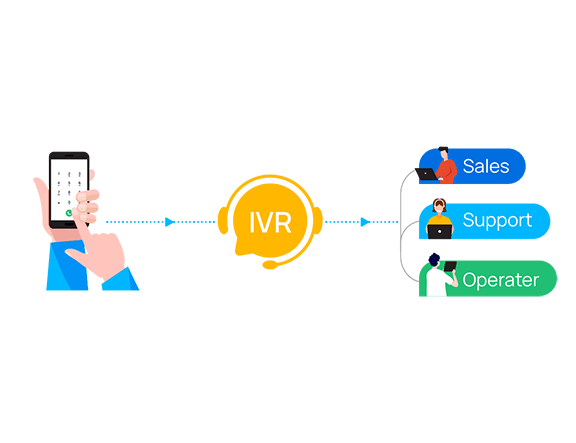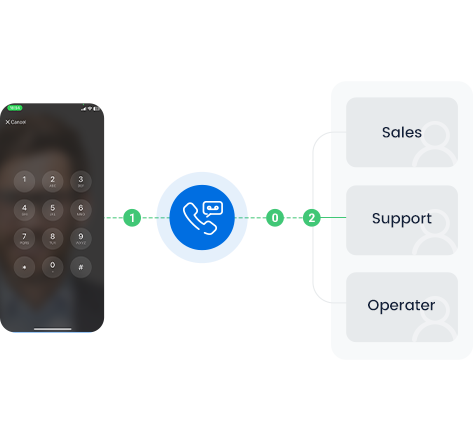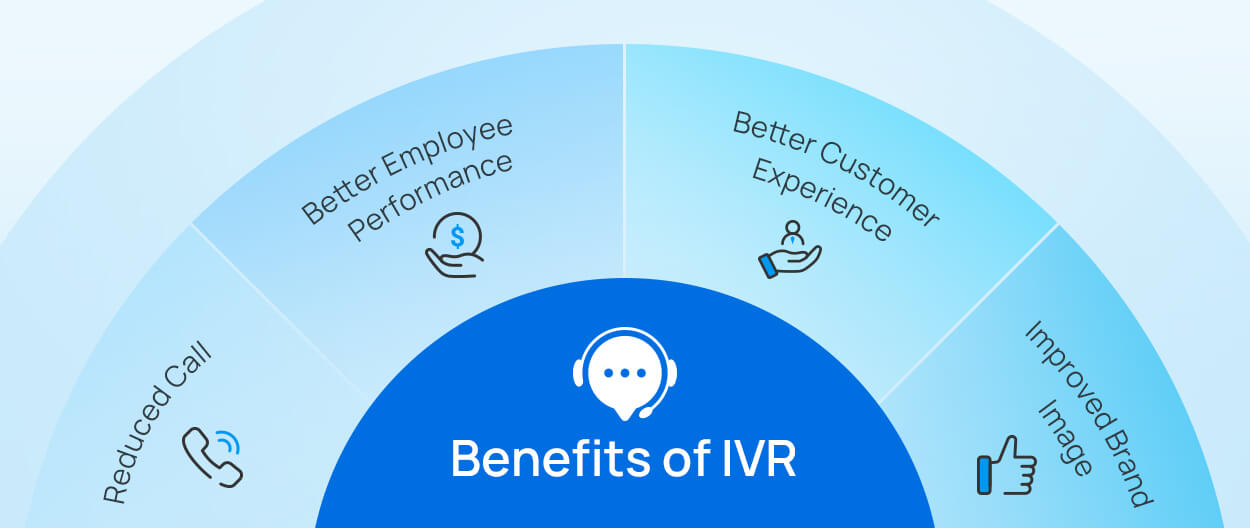 Customer support is crucial for every business as clients have questions that need to be solved as soon as possible. The most common (and fastest) way to reach a company is through a phone call, and even small businesses can experience a struggle to handle a high volume of calls. That’s when an IVR (or Interactive Voice Response) comes into play.
Customer support is crucial for every business as clients have questions that need to be solved as soon as possible. The most common (and fastest) way to reach a company is through a phone call, and even small businesses can experience a struggle to handle a high volume of calls. That’s when an IVR (or Interactive Voice Response) comes into play.
IVR powers the voice menu we usually hear when making calls (Example “Press 1 for sales; press 2 for support”) and helps customers get through to the best person to help with their queries.
Table of Contents
- What is IVR? →
- How does IVR Work? →
- Benefits of IVR Systems →
- Business uses cases of IVR →
- How to create IVR for your Business? →
- Frequently Asked Questions →
What Is IVR (Interactive Voice Response)?
IVR stands for Interactive Voice Response. It is a phone system feature that interacts with incoming calls from customers via voice or dialing, or it can also be used internally for business employees. IVR systems are commonly used in telephony applications to automate customer interactions, handle incoming calls, and provide self-service options.
Here is a short video showing a IVR works in real-world scenarios:
IVR systems typically greet callers with pre-recorded messages and offer various menu options for them to choose from using their phone’s keypad or voice commands. Depending on the selected option, the system can provide recorded information, route the call to a specific department or person, collect input from the caller, or execute other predefined actions.
Businesses often use the IVR technology to streamline customer service, enhance productivity, and reduce costs by automating routine tasks and providing self-service options 24/7. It can be integrated with other systems such as customer databases, appointment scheduling, and payment processing, enabling efficient and personalized interactions with callers.
How does IVR Work?
IVR works by using a combination of telephony technology and automated voice recognition to interact with callers and provide them with information or route their calls. Here’s an overview of how it typically work:

1. Greeting with menu options
When a caller dials a phone number, the call is connected to the IVR system. The system then greets the caller with a pre-recorded message or synthesized speech. It presents a series of menu options that the caller can choose from using their phone’s keypad or voice commands.
2. Caller input collection
The IVR system collects input from the caller through DTMF tones entered via the keypad or processing spoken responses using speech recognition technology.
Based on the selected option, the system can automatically respond to the caller’s query by playing a recorded message, transferring calls to appropriate departments, or performing various tasks requested by the caller.
3. Call routing
If necessary, the IVR system can intelligently route the call to the appropriate destination within the organization. This might involve transferring the call to a specific agent, or department, or forwarding it to voicemail. It often serves as an essential part of the ACD routing of a call center, which helps to route calls intelligently based on priority, agent skill levels, time of day, language preferences, and more.
4. Integration with backend systems
IVR systems often integrate with customer databases, CRM systems, order management platforms, or other backend systems to access and update relevant data during the call.
Why do you use IVR?
Even though IVR systems are automated and provide callers with limited options, they have many benefits. Some of the key advantages are:
Reduced Call Numbers
The less time they spend on the call, the more people your company can serve. Customers no longer need to call a general reception line. They can now use IVR to be directed to the right department. The customer call is instantly answered and directed to the requested department. Even if there is no suitable option for the customer to choose from the promoted voice menu, the caller can select to talk to agents.
Better Employee Performance
One of the most important pluses of interactive voice response systems is that it allows employees to breathe freely and focus on more serious tasks, letting the technology deal with minor issues.
Better Customer Experience
Whether your company is a call center, insurance office, or department store, you need to improve customer satisfaction constantly. Your buyers expect you to answer all of their questions, even during non-business hours. So, to avoid negative feedback, you can add the most important guidelines for your callers to your IVR menu.
Improved Brand Image
Interactive response helps a call center and other businesses quickly and efficiently resolve issues of inbound calls, which in turn raises credibility and brand image in the eyes of consumers. The system assists enterprises that struggle with high call volumes. It’s one of the most effective and profitable solutions that a company can invest in.

Business Uses Cases of IVR
Many features can be implemented into your IVR application to improve the customer experience and enhance the company’s performance.
Multilingualism
Multi-lingual IVR can support callers in various languages. This feature is essential if you are located in a cosmopolitan city where English is not a lingua franca. Or, if you assist lots of customers from various countries in different languages – the technology can sort out the lines for each language, so the calls aren’t mixed up. Communicating in the mother tongue, the clients feel more relaxed, and there is no place for misunderstanding or misinterpreting anything.
Offering a Callback
IVR technology allows callers to request a call back when there are many incoming calls. This option helps improve the customer service experience by reducing wait times. The company agents will have less stress and can fully assist the clients later. It sends the callers’ phone number and possibly preferred date and hour for a callback to agents to dial at a less busy time.
Asking For Feedback
Another great use of IVR is that they can analyze customer satisfaction by asking them their opinion or feedback after receiving the service, and transfer customer input data back to the connected system like contact centers for further analytics.
Marketing
Due to the high volume of inbound calls, Interactive Voice Response can collect data about inquiries for in-depth research and development of the system. Additionally, it can process the data that possesses valuable information for business strategies.
Before listing the menu, you can also upload messages to your IVR application to inform your clients about the latest promotions, updates, changes, or other important news.
Identification
Some IVR systems can be upgraded to conduct the identification process, and once the caller’s identity is confirmed, the automated system can instantly provide information previously logged into the system.
Self-Service
IVR systems can easily deal with simple transactions without an agents’ help. This feature lets agents focus on more serious tasks, allowing the system to quickly resolve non-complicated cases. Even if the IVR menu is pre-recorded, the technology has speech recognition features, and it uses natural language to interact with clients to provide the best solutions.
How to Implement IVR Phone System for Your Business
When you implement IVR, you need to create a clear and simple call flow that works best for your organization. And use a business phone system like Yeastar that supports multi-level IVR, multi-lingual IVR, and time-condition-based IVR. You can customize your own welcome voice and redirect callers to their desired department, extension or voicemail, etc. If the caller is on hold, it is advised to play calming pleasant music and inform the caller approximately how much time is left to wait.
To route calls efficiently, there are three more factors you shouldn’t forget about:
Create a Straightforward IVR Menu
Whether you have a call center or other company where there is a large call volume daily, your Interactive Voice Response menu should be simple and not too long. It shouldn’t be hard for the customer to find the right department. Your menu should be divided into levels, where one option leads to another, rather than presenting everything at once.
In order to make the phone experience clear, it is recommended to start with general categories that will develop into more detailed ones as the caller navigates the menu. But also do not make it too long; otherwise, it can become confusing.
Include Human Interaction
You can create very straightforward and interactive IVRs; however, your callers might not be willing to cooperate with this technology. Do not forget to let your callers interact with a live agent, and do not leave this option at the end of the menu.
Include a Callback Option
Waiting in line or on hold can be very annoying, and it greatly reduces the customer experience. Instead, Interactive Voice Response can offer a callback to a waiting client. This way, the employees will have fewer inbound calls, and a live agent will be able to reach the previous callers at calmer times.
Frequently Asked Questions
What Makes a Great IVR Experience?
Interactive Voice Response lets callers and companies save time and money; it reduces the volume of customer calls because the menu options navigate them to different departments. It collects, stores, and processes valuable data for future research and improvement. It also has an abundance of functions that can be helpful for your business.
Can IVR Fully Replace Human Interaction?
Modern IVR software has the feature of voice recognition, and it can also speak the natural language. It can be very helpful, dealing with straightforward queries from callers using an automated machine. However, this assistant is not yet fully accepted by everyone; that’s why companies should always employ representatives who can support human interaction with clients.
How Can IVR Application Improve Employees’ Performance?
If self-service is available to clients, employees can use IVR to ask for feedback and opinions of the service. It can also broadcast important news among the employees at the company or send satisfaction surveys. IVR applications can be programmed to notify employees of new vacancies or the beginning of projects.
Can IVR Technology Be Used in Other Businesses than Call Centers?
IVR systems can be used by:
- Hospitals
- Call Centers
- Hotels
- Insurance companies
- Stores
- Government offices
And many other businesses where staff is limited but there is an increase in call flows during and out of business hours. Since IVR is an automated technology, it can improve customer experience by dealing with simple tasks or by call routing to a human operator.
In Summary
Interactive Voice Response provides affordable solutions to companies with many inbound calls and limited customer support agents. It can be changed and improved, and you can always add new categories or new messages to it, making the IVR phone experience easy, clear, and helpful. When you’ve worked out why you need an IVR and what’s going to go into it, it’s time to choose the right technology partner.
Yeastar business phone system provides both advanced IVR features for both daily business and call center scenarios. Trusted by 450, 000 users, Yeastar is ranked by Gartner as a leader in the industry for its leading easy-to-use designs and all-inclusive features.
So, if you’re in need of an IVR solution and want to be in the hands of people who recognize that customers and businesses deserve better, see what Yeastar can do with our 30-day free trial. You can start in minutes with no commitments.


What’s up i am kavin, its my first occasion to commenting anywhere,
when i read this post i thought i could also create
comment due to this sensible paragraph.
Hi Kavin,
Of course. We’d love to talk about VoIP with you, so let me know if you have any ideas, please.